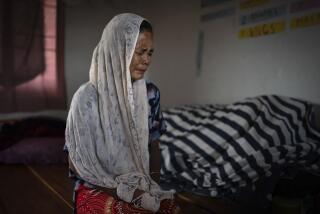Rebels kill 54 at India outpost
- Share via
NEW DELHI — Communist rebels besieged a police outpost in eastern India on Thursday, killing 54 people and wounding nearly a dozen more before fleeing into the surrounding jungle under cover of darkness.
The early morning raid was one of the bloodiest attacks in years by the so-called Naxalites, Maoist insurgents who have waged an armed campaign against the Indian government for four decades. Prime Minister Manmohan Singh has called the group the nation’s No. 1 threat to public security.
Police said that about 2 a.m. Thursday, up to 500 rebels descended on the remote outpost in the district of Bijapur, at the southern end of the troubled state of Chhattisgarh, which has borne the brunt of Maoist violence. The guerrillas opened heavy fire and hurled grenades and gasoline bombs at the station, which was staffed by a joint force of police and members of a state-sanctioned anti-Maoist militia.
The rebels seized a cache of 33 weapons, then vanished into the thick forest that blankets the area where Chhattisgarh meets the states of Maharashtra and Andhra Pradesh.
Some probably fled across state lines, said police Supt. Prabir Das, who is in charge of Chhattisgarh’s anti-Naxalite operations.
“Boundaries exist for us; they don’t exist for these guys,” Das said by telephone from the state capital, Raipur.
Das said that 38 militiamen and 16 police officers were killed. They were among the 75 people at the station. Efforts to rescue the injured, recover the dead and hunt the attackers were complicated by the typical guerrilla tactic of strewing the vicinity with land mines.
It was the single deadliest eruption of communist extremism in India since July, when insurgents stormed a government-run relief camp in Chhattisgarh, killing at least 32 people.
The New Delhi-based Asian Center for Human Rights estimates that 749 people, including 285 civilians, were slain last year in Naxalite violence.
This month alone, at least a dozen other police officers in Chhattisgarh have died in Maoist-related incidents. And on March 4 in neighboring Jharkhand, another dirt-poor state where the rebels have made inroads with their ideology of peasant revolt, a member of the national Parliament was shot to death by suspected Naxalite assassins.
Analysts warned that the rash of violence could presage an escalation of attacks across the “red corridor,” a swath of land from Andhra Pradesh in the south up to the Nepalese border in which the Maoists have established a strong presence.
At a meeting at the end of January, rebel leaders decided to expand their operations to other parts of the country, said Ajai Sahni, executive director of the Institute for Conflict Management.
“This suggests this is the beginning of a much wider operation. That is a very clear intention,” Sahni said.
Officials also accuse the communist rebels of having had a hand in rural unrest in West Bengal that resulted in a clash with police Wednesday in which 14 protesters were killed. Farmers in the Nandigram area are upset with government plans to acquire their land to set up an industrial park.
It was in West Bengal that the Naxalite movement was launched in 1967.
Named after the district of Naxalbari, where the uprising began, the insurgents claim inspiration from communist Chinese leader Mao Tse-tung’s teachings of rebellion in the countryside.
The rebels have flourished in impoverished areas where the Indian government is often absent.
“It’s not merely a police presence that’s required but a much larger administrative presence that will convince people they have a stake in the state,” Sahni said.
“It’s this vacuum of administration in which you see the Maoists operating.”
To supplement the police, the government two years ago began sponsoring the anti-Maoist militia known as the Salwa Judum. But critics accuse the militia of human rights abuses and say it has aggravated the conflict.
The worsening violence has displaced about 50,000 villagers who have fled their homes to live in squalid relief camps.
*
Times staff writer Shankhadeep Choudhury contributed to this report.
*
(BEGIN TEXT OF INFOBOX)
Back story
*
Taking their name from the Naxalbari district in West Bengal where they began in 1967, the Naxalites follow the rural revolutionary ideology of Chinese communist leader Mao Tse-tung.
*
They operate over a wide swath of India, from Andhra Pradesh in the south to the Nepalese border, hijacking trains, killing politicians and launching dramatic jailbreaks.
*
Villages have had to be evacuated as a result of burning, looting and slayings, mostly in the eastern state of Chhattisgarh. Rich in iron ore, coal and limestone, Chhattisgarh has become ground zero in the fighting. The Naxalites are battling the industrial extraction of resources.
*
In a bid to challenge the 15,000 guerrillas, Indian officials have armed thousands of villagers, mostly semiliterate and impoverished, forming a militia called Salwa Judum, or Peace March.
*
Sources: The Guardian, the Economist, Times reports
More to Read
Sign up for Essential California
The most important California stories and recommendations in your inbox every morning.
You may occasionally receive promotional content from the Los Angeles Times.











